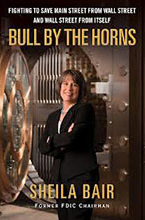The 2008 financial crisis caused a recession in the United States, forced the government to bail out several banks and investment firms to the tune of $125 billion and led to 1.9 million housing foreclosures in 2008 and 2009 due to lax and often predatory subprime mortgages. One of the few industries that may have benefited from this debacle was publishing, given that the economic collapse produced a number of books dissecting what went wrong. Sheila Bair, director of the Federal Deposit Insurance Corporation (FDIC) from 2006 to 2011, has added to that collection. In Bull by the Horns: Fighting to Save Main Street from Wall Street and Wall Street from Itself, Bair gives an insider’s view of what caused the crisis and what can be done to prevent similar meltdowns in the future.
Some of the most notable books that preceded Bair’s include New York Times’ reporter Andrew Ross Sorkin’s Too Big to Fail: The Inside Story of How Wall Street and Washington Fought to Save the Financial System — and Themselves, former Treasury Secretary Henry Paulson’s On the Brink: Inside the Race to Stop the Collapse of the Global Crisis and David Wessel’s In Fed We Trust: Ben Bernanke’s War on the Great Panic. So many economic crisis tomes were cranked out in 2009 that the Huffington Post published its “10 Best List” of financial crisis books three years prior to Bair’s entry.
While Bair’s book arrives late to the party, she brings a distinctive perspective to decoding the Wall Street debacle that almost no other book offers: a woman’s viewpoint. Invariably, she is the only woman in a room typically filled with powerful titans of finance. In the opening scene of her prologue, set at the height of the crisis in 2008, Bair is about to meet with then-Treasury Secretary Henry Paulson, then-New York Federal Reserve Bank president Timothy Geithner and nine male banking CEOs including Jamie Dimon of JPMorgan Chase, Lloyd Blankfein of Goldman Sachs and Vikram Pandit of Citigroup (who resigned in October.) Together, the nine powerhouse CEOs controlled $9 trillion in assets and 70% of the U.S. financial system. Bair admits to trying to hide her anxiety in meetings with them. How many male authors would admit their nervousness? Bair provides an insider’s take on how the crisis played out and delivers a more personal viewpoint compared to the more detached male authors.
Several other factors contribute to Bair’s unusual viewpoint on the crisis. She was nominated by President George W. Bush as FDIC director in 2006 but impressed President Barack Obama with her non-partisanship and competence, and was retained in that position when he took office. Raised in Wichita, Kansas, Bair sees herself as a moderate Republican who stands up for her team and tries to boost her staff’s morale. Bair is a straight-shooter who speaks her mind and looks out for everyday Americans living and working on the Main Street alluded to in the title. Bull by the Horns is symbolic on several levels: Bair is charged with reining in the bulls that symbolize Wall Street, who, at the dawn of the crisis, are running amok, misleading consumers while commandeering million dollar bonuses. Bair is Annie Oakley trying to whip the guys into shape or, as Time once referred to her, one of the three “new sheriffs of Wall Street” (Mary Schapiro, chairman of the Securities and Exchange Commission, who will be stepping down this month, and Elizabeth Warren, U.S. senator-elect from Massachusetts, were the others).
In Bair’s universe, all politics are personal. While she is describing the major financial honchos deciding how to divvy up TARP’s $125 billion as a way to bolster the capital of these troubled banks, she is concerned that no one “bothered to consult me about who should be invited” to the negotiation table. She notes that the FDIC serves as the insurer of banks and guarantees their debt. Therefore, she thought she should be wielding considerable influence with both Paulson and Geithner. In fact, Bair spends much of the book underscoring the fact that she’s an outsider.
Nonetheless, by bringing the reader into these TARP meetings, she reveals what is really on the minds of the CEOs. As they are wrestling with how much money each bank needs to shore up its capital reserve and restore it to health, then-Merrill Lynch CEO John Thain (now CEO of CIT) concentrated on whether executive compensation would be reduced, a stance that leads Bair to wonder about Thain’s priorities.
It is left to the regulators to control the rampant greed in financial services, but they operate more like warring Little Leaguers than cool-headed professionals. Bair exposes the rifts and competition among regulatory agencies dedicated to ensure that banks comply with the rules that guide financial conduct. Rather than collaborating as teammates to control the excesses of Wall Street, the regulators — including the FDIC, the Office of the Comptroller of the Currency (OCC), the SEC and the Office of Thrift Supervision (OTS) — bicker and battle for turf. Repeatedly, Bair blames the OCC for being too close to the major banks, seeing things from their point of view, and not holding them accountable for their excess and profligate behavior. Eventually, she recommends eliminating the OCC.
Despite the mania to cut the federal workforce, Bair suggests that reductions in the government can damagebusiness, not help it. For example, she explains how cutbacks are hurting regulators and preventing them from safeguarding the banking system. In 1995, the FDIC had 12,000 employees to ensure solvency of the banking system. That number was cut to 7,300 by 2001, and 4,500 by the time Bair started in 2006. Bair blames Clinton Treasury Secretary Robert Rubin and former Federal Reserve Board chairman Alan Greenspan for the staff cutbacks and the philosophy of letting market forces rule. Reducing the impact of the FDIC and OCC has “led to the adoption of hands-off regulatory philosophies at all of the financial regulatory agencies that would prove to be difficult to change once the subprime crisis started to unfold,” Bair noted.
Despite the beneficial effects resulting from the $125 billion injected into financial services — such as restoring faith in banking, preventing banking from falling off the financial cliff and minimizing the loss of jobs — Bair disparages the effects of TARP. “The system did not fall apart, so at least we were successful in that, but at what cost?” she asked. Caught in the myopic world of financial meetings, Bair fails to see how saving the banking system helped Main Street and everyday Americans maintain their standard of living. Did Bair forget that in 2008, prior to the bailout and stimulus, the U.S. lost two and a half million jobs, and the gross domestic product was falling at a rate of 9%? In this case, she seems doctrinaire, focusing only on how TARP’s funding drained precious governmental resources instead of contributing to the common good and shoring up struggling banks. She can’t fully grasp how TARP saved, not battered, the financial services industry.
In Bair’s dissection of what precipitated the subprime mortgage fiasco, she identifies several banking strategies that led to the downfall, including securitization. When large banks sell a collection of residential mortgages to large investors — such as pension funds, hedge funds, insurance companies or Fannie Mae and Freddie Mac — it is described as securitization. The banks were paid in advance for these loans, and investors did minimal or no due diligence on them. Hence, banks received incentives for selling mortgages in droves. Many homeowners received a mortgage with zero down payment and variable interest rates, and with salaries that were not high enough to repay the loan. Since the banks were “pooling” all the loans, they looked the other way and never considered the effects on homeowners or the economy when foreclosures proliferated. It was the equivalent of a scam, but most banks made their money and never looked back or considered the consequences.
Bair goes into elaborate detail describing banking products like collateralized debt obligations (CDOs) and credit default swaps, which also involve buying and selling of mortgages. She explains how the banks benefited from this wheeling and dealing, how regulators didn’t hold them accountable and how the average homeowner was duped. Where were the regulators? Why didn’t the OCC, FDIC and OTS hold these banks responsible and try to stop the use of these predatory practices?
Based on Bair’s portrayals, the regulators seem overmatched and understaffed, and rarely show initiative. She accuses most of the leaders of these regulatory agencies of being too close to the industry, although she considers herself the exception to the rule (despite her insider credentials; she worked as an assistant secretary in Treasury). But she lets the FDIC off the hook. During her tenure, the FDIC closed a whopping 365 regional banks holding more than $650 billion in assets. Bair writes that many of these banks “were poorly managed and took excessive risks,” but couldn’t the FDIC and other regulators have audited them, suggested changes and tried to prevent the failures from happening? Don’t auto insurers do everything they can to prevent accidents, not just wait to negotiate claims?
Nor does Bair accept any responsibility for the subprime mess. She writes that, “Fortunately, the FDIC had had extensive experience with securitization.” So why didn’t Bair speak about its potential damaging effects on homeowners? Why didn’t she hold a press conference? Use her influence? All she says is that the other regulators, not the FDIC, “were the primary players in the mortgage market.” Why didn’t the FDIC speak up when its major constituents, the banks, were buying and selling mortgages that could lead to their downfall?
Bair also uses her book to settle scores, particularly with Geithner, who was named President Obama’s Treasury Secretary in 2008. In Bair’s view, Geithner repeatedly slights her, doesn’t respect her or confer with her and steamrolls her. In return, she lampoons him, calling him an “instigator” and “little boy” and portraying him as an apologist for the big banks.
Yet Bair does an effective job of portraying Wall Street’s hypocrisy and greed. After receiving the $165 billion bailout, Wall Street executives rewarded themselves with large bonuses at taxpayer’s expense. Why couldn’t the bailout money prevent, or at least limit, this largesse? She repeatedly makes the point that Paulson, former CEO of Goldman Sachs, and Geithner, who worked for Rubin and Lawrence Summers at Treasury and the Federal Reserve Bank in New York, and most governmental executives come from the large investment banks and are too cozy with them. Where are the independent watchdogs who are not beholden to the financial system and Wall Street?
At the book’s conclusion, Bair recommends remedies that will prevent another bank bailout from ever occurring. Though her suggestions are sound, most of them have been discussed before — such as raising capital requirements (which is included in the Dodd-Frank Act), banning bailouts, breaking up the “too big to fail” mega-institutions like Citigroup and strengthening the new Consumer Financial Protection Bureau. In a more unorthodox move, she suggests raising the capital gains tax which alone would generate millions from wealthy investors. Had some of these suggestions been in place, she says the bailout could have been avoided.
Taking the “bull by the horns” would have required Bair to do more digging, more interviewing and more investigating into where the FDIC went wrong rather than masking its limitations. Right now, the bulls are still leading the way, and Wall Street and the stock market have bounced back — thanks, to a large degree, to that $125 billion in TARP money.



